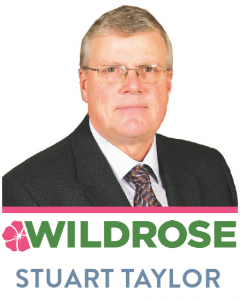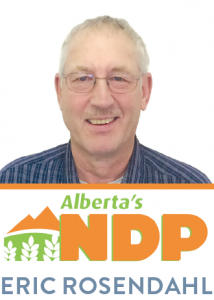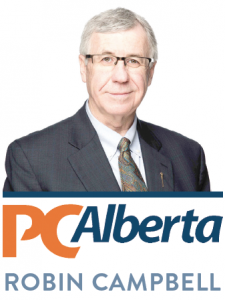Albertans will be heading to the polls for the 29th time in the province’s history, May 5. The stakes couldn’t be higher with global oil prices plunging, income taxes on the rise, and the government facing a record $5-billion deficit. The election will test the Progressive Conservative party’s 43-year grip on power against the policies and ideas from the Wildrose, New Democratic Party and the Liberals.
Last week the Fitzhugh interviewed each of the candidates in the West Yellowhead riding, and this week we posed questions to each of those candidates. Presented here are their responses.
 1. If elected, your party plans to cut taxes as well as save $ 2.2 billion dollars by streamlining government inefficiencies. How will you be able to cover the current $ 7 billion shortfall caused by the fall of oil prices without cutting frontline workers?
1. If elected, your party plans to cut taxes as well as save $ 2.2 billion dollars by streamlining government inefficiencies. How will you be able to cover the current $ 7 billion shortfall caused by the fall of oil prices without cutting frontline workers?
Good government is about the ability to develop budgets and effectively allocate resources. No other province, even on the very best years, will collect oil royalty revenue anywhere near what Alberta takes in on the very worst years, when energy prices are at the bottom end of the cycle. Alberta has enormous economic advantages.
Alberta has been pumping oil since the 1940s. We’ve also had a PC government for more than 40 years. It’s projecting that by 2019, the province will be $31 billion in debt. Norway has been pumping oil about a third as long, or less. Its savings fund, modelled after the Lougheed Heritage Fund, holds $1 trillion.
Norway is the envy of the world. This is not to suggest Alberta should do everything Norway does. There are distinct differences. It is to suggest that Alberta’s fiscal managers are a failure.
Alberta’s financial problems started over a decade ago when annual program spending would jump by 11%, 12%, or more. In Ed Stelmach’s first year as premier he increased spending 20.4%.
Wildrose will eliminate 3,200 upper level positions. (Worker to manager ratio in government is roughly 5-to-1. In the private sector it’s 20-to-1 or higher.) We’ll rollback the PCs 30% Cabinet pay hike, and the 8% hike MLAs pocketed. We’ll end corporate welfare. Period. We’ll end “March Madness”, the bureaucratic spending spree that wastes millions when government agencies empty bank accounts at the end of the fiscal year.
One of the biggest savings will be realized through realigning infrastructure. Politicized infrastructure spending will end. Never again will PC MLAs run around at election saying, “Vote for me I’ll build you a ____(fill in the blank).” By establishing publicly-known criteria to quantify infrastructure priorities, and by ending sole source contracting, we can dramatically improve efficiency.
2. The Evergreens Foundation received significantly less provincial funding than was expected for its expansion and renovation of Parkland Lodge in Edson, putting added pressure on the region’s taxpayers. How will your party ensure funding for adequate seniors’ housing in the West Yellowhead riding?
The current government has a helter-skelter approach to capital construction which analysts regularly point to when they explain the unreliability and high costs of Alberta’s infrastructure system. Generally, priorities are established not by objective criteria, but by Cabinet Ministers at election time who run around the province brimming with promises.
The Wildrose Party will develop a measurable, objective, publicly known process for prioritizing infrastructure spending. Every project, including the Parkland Lodge Project, would be treated fairly, and in the same manner as every other project. The measurable criteria will establish the priority, and the order in which dollars would be allocated.
This is the absolute best option in our view for provincial infrastructure spending. The idea that Alberta’s infrastructure priorities should be almost entirely dependent on campaigning politicians bearing promises at election time, is unworthy of Alberta.
3. If elected will you lobby for resort municipality status and funding for communities like Jasper, Banff and Canmore, all of which are required to maintain infrastructure for much larger volumes of people than make up their tax base?
This is exactly the sort of unique issue that a grassroots political party can easily address. Wildrose is committed to free votes in the legislature on all policy issues, meaning MLAs would have much more latitude to work with other MLAs to initiate legislation and other provisions. Wildrose wants to end the practice of “whipped” votes where MLAs are always being told what to do, or how to vote. Therefore local issues would have a greater chance of success.
It’s clear to me that the provincial government’s funding model—which is based on population, assessment, and kilometres of road, doesn’t work for some jurisdictions like Jasper, Banff and Canmore.
I’d be thrilled to work closely with Jasper, and other MLAs in a free vote legislature, to develop a solid plan. A solution that could be widely supported by the business communities would, in my view, stand the best chance of success.
4. How can Alberta better support its municipalities, in particular in small towns?
Wildrose policy is the same today as it has been all along. We are committed to provide 10% of all tax revenues, from all sources, to municipalities, as well as 10% of every budgetary surplus.
This creates incentive throughout the province for a performance-oriented provincial government, as well as a public appetite for economic growth and annual budgetary surpluses at the provincial level.
I believe it is absolutely vital that the provincial government gets a handle on debt. This issue is going to dramatically affect municipal funding. Here’s why:
The recent PC budget is calling for $31 billion in debt by 2019. The interest on $31 billion will be between 1½ and 2 billion dollars a year. Assuming a cost of $1 million per mile, that’s enough money to pave a highway from West Yellowhead to the Mexican border, every year, year after year after year.
This PC debt will require every Alberta family to pay between $1,700 and $2,000 a year in taxes, just to cover interest—money for which taxpayers get nothing in return. Over a ten-year period this is an amount approaching $20 billion, which will inevitably affect municipal funding.
The single biggest enemy of reliable municipal funding is provincial debt. It is a cancer that should be avoided just as surely as people should avoid cigarettes and other cancer-causing agents.
The Wildrose fiscal plan will bring Alberta back to balanced budgets by 2017, lessen new debt by $15 billion, and quickly return us to jobs and growth. Even then, because of PC spending decisions that have already been set in motion,
Albertans will still be carrying some unwanted debt.
The people of West Yellowhead have an important choice to make—higher taxes and more debt, or lower taxes, smaller government, and an improved long-term ability to fund municipalities and services.
 1. Rachel Notley recently said the NDP is in it to win it—not to be the official opposition. Can you clearly define how the NDP would lead the province out of the current budget shortfall?
1. Rachel Notley recently said the NDP is in it to win it—not to be the official opposition. Can you clearly define how the NDP would lead the province out of the current budget shortfall?
- Large profitable corporations will contribute a little more. We will cut the PCs wasteful corporate tax breaks, while maintaining Alberta’s competitive business environment by raising the corporate tax rate by two per cent.
- The highest income earners will contribute a little more. We will introduce a high income progressive tax system that asks the top 10 per cent of tax filers to contribute to the services that all Albertans depend on, based on their ability to pay.
- New Democrats will boost efforts to collect delinquent, unpaid corporate taxes and will increase the railway fuel tax to get it in line with other provinces.
- We will eliminate $200 million in wasteful subsidies and tax breaks to corporations and will search for efficiencies and end PC wasteful spending.
- Everyone else, 90 per cent of tax filers, get a break from provincial taxes and fees Jim Prentice proposed in his recent budget.
2. The Evergreens Foundation received significantly less provincial funding than was expected for its expansion and renovation of Parkland Lodge in Edson, putting added pressure on the region’s taxpayers. How will your party ensure funding for adequate seniors’ housing in the West Yellowhead riding?
- Alberta’s NDP is committed to ensuring that seniors have the housing they need at affordable rates. New Democrats will make sure seniors get the care they need and end the PC approach of forcing seniors to use hospital services.
- Alberta’s NDP has a plan to ensure that municipalities are able, through inclusive zoning, to mandate new developments to feature affordable housing units for seniors and families in a neighbourhood.
- Rather than taking public funds and giving it to private developers and private health companies, like the PCs have through the Affordable Supportive Living Initiative (ASLI), Alberta’s NDP will focus on providing affordable housing for seniors by shifting funds back to facilities that are community-run either by non-profits, religious organizations, or the province.
3. If elected, will you lobby for resort municipality status and funding for communities like Jasper, Banff and Canmore, all of which are required to maintain infrastructure for much larger volumes of people than make up their tax base?
- Alberta’s NDP understands the position that communities heavily involved in the tourist industry face when it comes to revenues: while you need to provide top notch infrastructure and services in order to attract folks to your community, those tourists do not pay permanent property taxes or other revenue tools to your towns or villages.
- This is not an unfamiliar position for many municipalities around the province: many are feeling the crunch.
- Whether it is a special status for resort communities so they can claim more revenue from provincially-administered taxes, or granting towns and cities additional revenue tools through the review of the Municipal Government Act, Alberta’s NDP is committed to sitting down with resort communities to ensure that together we can find a solution that provides towns and municipalities with stable, predictable funding that addresses their increasing needs.
4. How can Alberta better support its municipalities, in particular small towns?
- First, there needs to be a relationship of respect between partners.
- We need to ensure that municipalities (including small towns and villages) receive stable, predictable funding so they can follow through on the priorities they have for their own communities.
- Alberta’s NDP also has a plan to ensure that rural communities have access to needed health care, education and infrastructure services.
- We plan to work with bus companies to ensure that smaller communities are able to have transportation links between them.
 1. Why should Albertans trust the current Progressive Conservative government to pull the province’s budget out of deficit, when your government did not adequately plan for the current fall in oil prices?
1. Why should Albertans trust the current Progressive Conservative government to pull the province’s budget out of deficit, when your government did not adequately plan for the current fall in oil prices?
Nobody predicted the sudden drop in world oil prices. Jurisdictions across the globe have been impacted by this and have had to adjust. We are the first government to bring in a long-term 10 year plan that will reduce our dependence on oil royalties while protecting front line services, our seniors and the most vulnerable. Over the next three years we will balance the budget by reducing spending, increasing revenue and using our contingency account. This is a balanced approach that will keep frontline services intact while not overburdening taxpayers. Our plan will also ensure that we don’t tip the province into a recession during this economic slowdown. Many leading economists support our approach and say it strikes the right balance.
Over the 10 years we will reduce our dependence on oil, using the royalties as a bonus to pay down our capital debt and put into the Heritage Trust Fund, doubling its value in 10 years. This will protect government programs and services from the volatility of oil prices and allow us to be consistent in the services we provide Albertans no matter the price of oil. It is a comprehensive plan that will break the boom and bust cycle in the province. You can read more about our plan at www.robincampbell.pcalberta.com.
2. The Evergreens Foundation received significantly less provincial funding than was expected for its expansion and renovation of Parkland Lodge in Edson, putting added pressure on the region’s taxpayers. How will your party ensure funding for adequate seniors’ housing in the West Yellowhead riding?
Over $12 million was provided to the Evergreens Foundation for the Parkland Lodge from the provincial and federal governments.
In addition our government is providing $4.8 million for the expansion of the Hinton Mountain View Centre.
We are also building 76 continuing care beds at the new Edson Hospital. As you know six years ago we provided significant funding for the Alpine Summit Seniors Lodge in Jasper and the new lodge in Grande Cache. These are significant investments into seniors housing in the region. The additional spaces in Hinton and Edson will alleviate the pressure and address the needs we have for seniors housing in the region.
3. If elected, will you lobby for resort municipality status and funding for communities like Jasper, Banff and Canmore, all of which are required to maintain infrastructure for much larger volumes of people than make up their tax base?
Municipal Affairs is currently undergoing a comprehensive review of the Municipal Government Act and I encourage all area municipalities to bring their views to that table for any changes that they believe are required.
The Government of Alberta provides significant infrastructure funding to municipalities such as Jasper through the Municipal Sustainability Initiative. For 2014-15 this provided approximately $2 million for the Municipality of Jasper to assist with local priorities. We also provide additional support through Tourism Alberta to help build tourism in the constituency and I’m working with Jasper and Tourism Jasper on bringing regional air service to the West Yellowhead which will help boost tourism in Jasper and the entire riding.
4. How can Alberta better support its municipalities, in particular small towns?
Many of the priorities we are focused on in our long-term 10 year plan are important to municipalities and in particular small towns. First and foremost we must continue to keep Albertans working. This is why a big part of our 10 year plan is focused on economic diversification and ensuring that we continue to be the lowest taxed jurisdiction in Canada.
As we attract investment and create opportunities for business to be successful, communities benefit through job creation, municipal taxes and economic spin-offs.
MSI funding is another aspect of how we will support municipalities. Continuing to invest in infrastructure is important. In order for small towns to survive, they need quality schools, roads, hospitals and seniors facilities. That is one of the reasons why our plan includes $29.5 billion in infrastructure spending over the next five years.
As you know we recently built the Jasper Junior/Senior High School and we are investing money for upgrades to Hwy 40, 16 and 47 as a part of this year’s budget. These are important investments that will create jobs and help support our communities.
We simply can’t afford not to build infrastructure. Our capital plan will support municipalities and ensure infrastructure priorities are met.
As mentioned previously, there is also a Municipal Government Act review underway that is looking at ways that we can better support municipalities. This review is being done in a collaborative effort with municipalities at the table discussing issues that are important to them.
